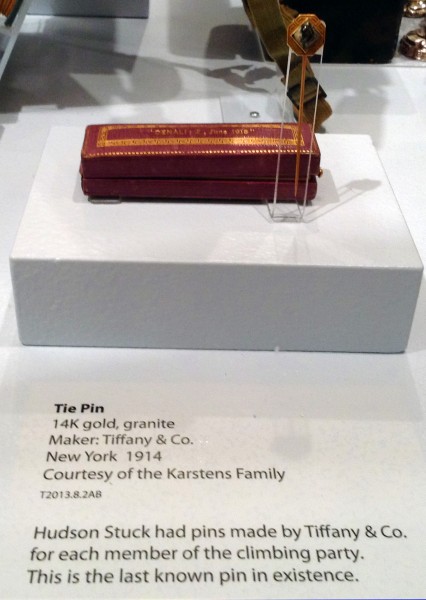Family legacies celebrated at UA Museum of the North
April 15, 2014
907-474-6941
4/15/14

This is the last week visitors can see the special exhibit Denali Legacy: 100 Years on the Mountain at the University of Alaska Museum of the North. The installation tells the story of the first people to reach the summit of North America’s tallest mountain. Guest Curator Angela Linn managed to track down several artifacts from the climb, including all four journals kept by the men who reached the top: Walter Harper, Harry Karstens, Hudson Stuck, and Robert Tatum. The story of the climb is told through excerpts from those slim volumes.
Linn says our stories are important because the represent the unique experiences of individual people. “Contained in those stories are our personal perspectives and our emotional reactions to particular circumstances, all of which help present-day people understand how certain events in history were received by people of that time.”
Personal stories recorded at the time of those events can help us strip away our modern biases. Linn says they allow us to see the events though the eyes of those who lived through them. “When we preserve our thoughts in journals, letters, or even record them on tape or in digital form, we are leaving a lasting impression of ourselves and our unique view of the world for future generations to discover.”
The exhibit also features the few remaining objects from the climb that have been preserved, each of them kept by either a dedicated family member or an institution. For example, the climbers had four axes made by a Fairbanks blacksmith when their mail-ordered supplies didn’t arrive in time from the East Coast. Only one of them has survived, carefully protected by Harry Karstens’ grandson Eugene.
Linn says objects transcend their importance when viewed as historical artifacts. "Objects act as symbols of actual events, they represent certain time periods and they can act as triggers for personal memories. Stories about specific objects help to bring people together to understand the particular context and relevance of an item and what it may have meant to at least one single person."
At a recent Family Day at the museum, visitors shared objects that are important to their families. Museum Educator Maïté Agopian says the exhibit was a great opportunity to reflect on our own legacies. “Having people think about what they have in their own house was interesting. Sometimes, just by thinking about it for a few minutes, a visitor might make a connection to one of the objects on display. And then right away, a story came with it.”

We are surrounded by objects, all the time. In our houses and in our bedrooms. Some things were always there, while others are added to the collection in a constant stream of new items. Sometimes, we end up not seeing them as individual pieces. Agopian says being able to stop and focus on an object is a way for parents to tell their own stories. “That makes it is easier to relate to for a child, as there is something tangible to touch.”
Those of us who work in museums are obsessed with that potential moment of connection to the objects in our collections. But we hold them in the public trust, which means we are accountable to our community for them.
Linn says accepting an artifact into our collections means we are making a promise to take care of it and preserve it in perpetuity. “We might not know much about an item when it first comes to the museum. Maybe we accept it because it’s really beautiful or it was used by someone who played an important role in the story of Alaska’s history. By holding it in our collection, we’re ensuring that the object has the opportunity to have its story told at some point in the future.”
Agopian says the object is a starting point. From there we can learn about a culture, history, or make a scientific discovery. “So being able to to say, ‘Hey, what about you? What do you have in your house or in your room that can tell a story about your past?’ That’s a great opportunity.”
Denali Legacy will be on display in the Special Exhibits Gallery at the UA Museum of the North until April 21, 2014. There is more information on our website.


